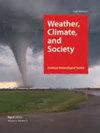Contextualizing disaster phases using social media data: Hurricane risk visualizations during the forecast and warning phase of Hurricane Irma
IF 1.9
4区 地球科学
Q3 ENVIRONMENTAL STUDIES
引用次数: 0
Abstract
Abstract Common disaster-phase models provide a useful heuristic for understanding how disasters evolve, but they do not adequately characterize the transitions between phases, such as the forecast and warning phase of predictable disasters. In this study, we use tweets posted by professional sources of meteorological information in Florida during Hurricane Irma (2017) to understand how visual risk communication evolves during this transition. We identify four subphases of the forecast and warning phase: the hypothetical threat, actualized threat, looming threat, and impact subphases. Each subphase is denoted by changes in the kinds of visual risk information disseminated by professional sources and retransmitted by the public, which are often driven by new information provided by the U.S. National Weather Service. In addition, we use regression analysis to understand the impact of tweet timing, content, risk visualization and other factors on tweet retransmission across Irma’s forecast and warning phase. We find that cone, satellite, and spaghetti-plot image types are retweeted more, while watch/warning imagery is retweeted less. In addition, manually generated tweets are retweeted more than automated tweets. These results highlight several information needs to incorporate into the current NWS hurricane forecast visualization suite, such as uncertainty and hazard-specific information at longer lead times, and the importance of investigating the effectiveness of different social media posting strategies. Our results also demonstrate the roles and responsibilities that professional sources engage in during these subphases, which builds understanding of disasters by contextualizing the subphases along the transition from long-term preparedness to postevent response and recovery. Significance Statement Visual information is an important tool for communicating about evolving tropical cyclone threats. In this study, we investigate the kinds of visualizations posted by professional weather communicators on Twitter during Hurricane Irma (2017) to understand how visual information shifts over time and whether different visuals are more retweeted. We find that visual information shifts substantially in the days before Irma’s impacts, and these shifts are often driven by changes in Irma’s strength or forecast track. Our results show that cone, satellite, and spaghetti-plot visualizations are retweeted more frequently, while watch/warning imagery is retweeted less. These results help us to understand how visual information evolves during predictable disasters, and they suggest ways that visual communication can be improved.使用社交媒体数据将灾害阶段置于背景中:飓风厄玛预报和预警阶段的飓风风险可视化
常见的灾害阶段模型为理解灾害如何演变提供了有用的启发,但它们不能充分表征阶段之间的过渡,例如可预测灾害的预测和预警阶段。在本研究中,我们使用佛罗里达州专业气象信息来源在飓风伊尔玛(2017年)期间发布的推文,以了解视觉风险沟通在这一过渡期间的演变。我们确定了预测和预警阶段的四个子阶段:假设威胁、实际威胁、迫在眉睫的威胁和影响子阶段。每个子阶段由专业来源传播并由公众重新传播的视觉风险信息种类的变化来表示,这些变化通常是由美国国家气象局提供的新信息驱动的。此外,我们使用回归分析来了解Irma预测和预警阶段的推文时间、内容、风险可视化等因素对推文转发的影响。我们发现锥形、卫星和意大利面图图像类型的转发量更多,而观察/警告图像的转发量较少。此外,人工生成的推文比自动生成的推文更容易被转发。这些结果强调了当前NWS飓风预测可视化套件需要纳入的几个信息,例如不确定性和更长的前置时间的特定危害信息,以及调查不同社交媒体发布策略有效性的重要性。我们的研究结果还展示了专业人员在这些子阶段中所扮演的角色和责任,通过将从长期准备过渡到事后响应和恢复的子阶段置于背景中,建立了对灾害的理解。视觉信息是沟通热带气旋威胁演变的重要工具。在这项研究中,我们调查了在飓风伊尔玛(2017年)期间,专业天气传播者在推特上发布的各种可视化图像,以了解视觉信息如何随着时间的推移而变化,以及不同的视觉图像是否会被更多地转发。我们发现,在“厄玛”影响前几天,视觉信息发生了重大变化,这些变化通常是由“厄玛”强度或预测路径的变化所驱动的。我们的研究结果表明,圆锥图、卫星图和意大利面图的可视化图像被转发的频率更高,而观察/警告图像的转发频率较低。这些结果帮助我们了解在可预测的灾难中视觉信息是如何演变的,并提出了改进视觉交流的方法。
本文章由计算机程序翻译,如有差异,请以英文原文为准。
求助全文
约1分钟内获得全文
求助全文
来源期刊

Weather Climate and Society
METEOROLOGY & ATMOSPHERIC SCIENCES-
CiteScore
3.40
自引率
13.60%
发文量
95
审稿时长
>12 weeks
期刊介绍:
Weather, Climate, and Society (WCAS) publishes research that encompasses economics, policy analysis, political science, history, and institutional, social, and behavioral scholarship relating to weather and climate, including climate change. Contributions must include original social science research, evidence-based analysis, and relevance to the interactions of weather and climate with society.
 求助内容:
求助内容: 应助结果提醒方式:
应助结果提醒方式:


